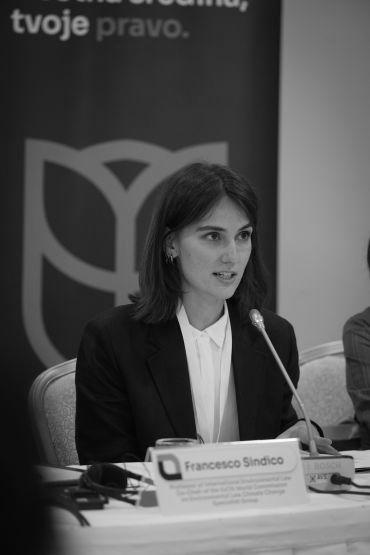The UK’s Climate Change Committee (CCC) delivered its recommendations for the Seventh Carbon Budget last week, setting out a ‘balanced pathway’ for how we can work towards net zero emissions from 2038 to 2042 (we are currently in the Fourth Carbon Budget period).
With the Climate Change Act 2008, the UK was the first country in the world to set legally binding carbon budgets. The Act mandates the government to set five-year carbon budgets that cap total greenhouse gas emissions.
So, what are the key takeaways from the CCC’s recommendations?
 Dr Injy Johnstone
Dr Injy Johnstone
Doubling down on domestic ambition
In a world where the majority of nations are considering utilising the emerging carbon trading framework under Article 6 of the Paris Agreement, the UK is able to do its bit domestically.
According to Dr Injy Johnstone, Oxford Net Zero Research Fellow in Net Zero Aligned Offsetting, ‘The UK’s Seventh Carbon Budget is 100% achievable domestically – sending a strong signal globally that potential emissions reductions at home should never be substituted with potentially risky and poor-quality carbon credits from overseas’.
This is important because Article 6 of the Paris Agreement is now in operation, having been finalised and agreed at COP29 in November.
New modelling choices, with some interesting implications
The Seventh Carbon Budget is delivered through a combination of approaches: electricity decarbonisation, low-carbon fuels and carbon capture and storage (CCS), nature, engineered carbon dioxide removals (CDR) and demand reduction measures. The target for the agriculture sector, for example, relies heavily on carbon removals from afforestation on pasture and a simultaneous decrease in livestock herd sizes.
 Jessica Zionts
Jessica Zionts
As Jessica Zionts, Oxford Net Zero Researcher and DPhil student at the Environmental Change Institute points out, the CCC assumes that agricultural ‘trade flows remain the same‘. Jessica is concerned that this could be problematic because it implies significant dietary shifts, despite a lack of complementary policy incentives to drive them.
Less of engineered removal “net” needed to reach net zero than previously thought
When it comes to engineered removals, Jessica is more positive: the CCC ‘have significantly walked back their bioenergy with carbon capture and storage (BECCS) target, which is good. The pressure on global land use competition posed by BECCS is a huge problem’.
This move is likely a response to ongoing debates about whether BECCS from virgin material (as opposed to waste, which is limited in supply) constitutes a negative emission in the first place. But Dr Injy Johnstone cautions that ‘this does not necessarily mean we should be limiting deployment of negative emissions technologies more broadly – the CCC is mandated to only consider a net zero, rather a than net-negative scenario, which we need to be in if we are serious about addressing the growing global carbon removal budget deficit’.
More engineered removals (probably) required for the aviation sector, which is likely to remain the largest source of residual emissions
 Millicent Sutton
Millicent Sutton
Aviation will continue to be the biggest source of ongoing emissions at the time of the Seventh Carbon Budget. Even then Millicent Sutton, Oxford Net Zero researcher, underscores that much of the CCC’s recommended emissions reductions in the sector ‘rely very heavily on Sustainable Aviation Fuels (SAFs) to deliver net zero in the aviation sector’.
SAFs are the lynchpin for the UK aviation decarbonisation strategy, so if SAFs do not scale to the required volume due to energy, land and resource constraints, then decarbonisation of the sector will be slower than expected. This means that aviation will emit more CO2, causing more effective radiative forcing than in the current balanced pathway, and so more removals may be required to compensate for the emissions reductions that otherwise would have been made using SAFs.
Millicent stresses that the CCC has made ‘a lot of optimistic assumptions about the rate of grid decarbonisation, the effectiveness of the SAF mandates, the decarbonisation behaviour of airlines, and the willingness of the UK public to prioritise jet fuel over other more essential land uses like food production’.
This is significant at a time when the implementation phase of the CORSIA international offsetting scheme for aviation has begun. However, the CCC has determined that it is to be likely ‘insufficiently rigorous to be incorporated into domestic carbon budgets’ as Sindi Kuci, researcher at the Oxford Sustainable Finance Group, explains.
Putting who should pay for emissions in the spotlight
The Seventh Carbon Budget marks a milestone with its explicit reference to the ‘polluter pays’ principle: giving a clear cue to industry that it must clean up or pay up for durable carbon removal. In some cases, this could include users of industries, such a frequent flier levy being introduced.
Sindi comments that recognition of the ‘polluter pays’ principle is also significant, in light of the fact that ‘the CCC recognises the differentiated responsibilities and capabilities of the UK as a developed country and contributor to past climate change’.
Recognition of the need to balance emissions and removals in a “like for like” manner
 Sindi Kuci
Sindi Kuci
In the Seventh Carbon Budget, the CCC also recommends that remaining emissions in agriculture and land use be balanced by the carbon sequestered by land-based sinks, with engineered removals for all other kinds of emissions.
Dr Johnstone explains ‘this clear endorsement of the need to match emissions sources and sinks in a like for like manner in tells hard-to-abate sectors that they cannot temporarily offset their way to net zero via nature. This means that sectors with significant emissions during the Seventh Budget window need to reduce their contribution to net zero, either by cutting emissions or investing in permanent removals – paving the way for genuine climate accountability’.
Where to next?
The recommendations from the CCC will now be considered by the UK government, who in turn must propose a Seventh Carbon Budget to Parliament for approval before 30 June 2026.
Oxford Net Zero is an interdisciplinary research initiative with researchers across 10 departments of the University. It produces high-quality research to inform policymakers, global industry leaders and international organisations in the global race to net zero.
The Smith School of Enterprise and the Environment helps build a cleaner, fairer and more prosperous future through solutions-focused research and bringing enterprise into the conversation.
The Oxford Sustainable Finance Group is a world-leading, multi-disciplinary centre for research and teaching in sustainable finance.
The Environmental Change Institute is an interdisciplinary research institute focused on the complex processes of global environmental change, the exploration of sustainable solutions and motivating change for the better through partnerships and education.
“The University of Oxford is a collegiate research university in Oxford, England. There is evidence of teaching as early as 1096, making it the oldest university in the English-speaking world and the world’s second-oldest university in continuous operation.”
Please visit the firm link to site



